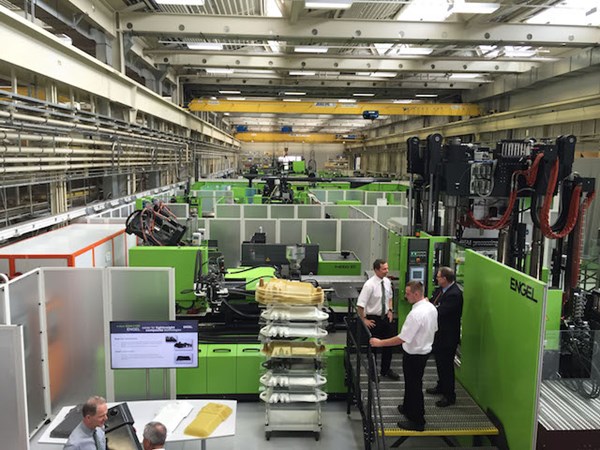Engel: Full speed ahead on composites R&D
CW attended the Engel Symposium 2015 and visited its Technology Center for Lightweight Composites in St. Valentin, Austria.

Peter Egger, director of the Engel Center for Lightweight Composites.
Injection molding manufacturer Engel recently hosted more than 3,000 customers and partners at its facilities in St. Valentin and Linz, Austria. I attended the symposium that took place in picturesque Austria and spent some time at Engel’s Technology Center for Lightweight Composites, which was established in 2012 at St. Valentin. Engel showcased the work being done at the technology center, while at the same time, calling attention to the importance of collaborative research in composites R&D.
Together with its partners Fill (Gurten, Austria) and Hennecke (St. Augustin, Germany), Engel demonstrated the HP-RTM process with a generic test component on an Engel v-duo 3550/1100 machine during the symposium. Hennecke is its partner for polyurethane processing; Fill specializes in the production and processing of fiber-reinforced composite preform elements. Thanks to the close cooperation with its partners, Engel can also provide highly integrated system solutions—including the production of preforms—for the production of FRP components from a single source.
Peter Egger, director of the Engel Center for Lightweight Composites, told me that the center allows the company to work on the intensive interdisciplinary development of fiber composite technology together with partner companies and universities.
Engel recently annouced that it is currently building a v-duo 3600 machine for the Open Hybrid Lab Factory in Wolfsburg, Germany. Engel is a founder member and sponsor of the research center initiated by Volkswagen in 2012 and supported by Germany’s Federal Ministry of Education and Research. With clamping force of 36,000 kN, the Engel v-duo 3600 is the largest machine in its series. One machine in the same clamping force class is installed at BMW’s Landshut factory, where large structural components of fiber-reinforced plastic composites are manufactured using the HP-RTM process.
Engel developed its v-duo series specifically for fiber-reinforced processing. In contrast to the presses conventionally used in such applications, Engel vertical machines have a relatively small footprint, the company says. The height and weight of the machines are much lower, which reduces the foundation building overhead. The clamping unit can be accessed from all four sides instead of just two due to a very high rigidity as well as the parallelism of the mold mounting platens.
Currently, the company is focused on solutions for the automotive market. (Egger did say they are also interested in both aerospace and electronics). With regards to lightweight design in the automotive market, new processes as well as new materials must be developed for automotive manufacturing.
“One of the biggest challenges is design—there are a lot of nice products, new materials and very good processes, but still a very big gap on how to design the parts for composites,” he said.

Each day, Engel stays focused on driving the industrialization of the composites process forward.
“The speed of development and the speed of getting composites in the marketplace is still quite low if you look at how long people are working with it,” Egger said. “The goal is go from handwork to serial production. The advantage of Engel is that we are more used to serial work and the quality control implementation that is part of the injection molding machine process.”
Related Content
Materials & Processes: Fabrication methods
There are numerous methods for fabricating composite components. Selection of a method for a particular part, therefore, will depend on the materials, the part design and end-use or application. Here's a guide to selection.
Read MoreNovel dry tape for liquid molded composites
MTorres seeks to enable next-gen aircraft and open new markets for composites with low-cost, high-permeability tapes and versatile, high-speed production lines.
Read MoreOne-piece, one-shot, 17-meter wing spar for high-rate aircraft manufacture
GKN Aerospace has spent the last five years developing materials strategies and resin transfer molding (RTM) for an aircraft trailing edge wing spar for the Airbus Wing of Tomorrow program.
Read MoreMFFD thermoplastic floor beams — OOA consolidation for next-gen TPC aerostructures
GKN Fokker and Mikrosam develop AFP for the Multifunctional Fuselage Demonstrator’s floor beams and OOA consolidation of 6-meter spars for TPC rudders, elevators and tails.
Read MoreRead Next
CW’s 2024 Top Shops survey offers new approach to benchmarking
Respondents that complete the survey by April 30, 2024, have the chance to be recognized as an honoree.
Read MoreComposites end markets: Energy (2024)
Composites are used widely in oil/gas, wind and other renewable energy applications. Despite market challenges, growth potential and innovation for composites continue.
Read MoreFrom the CW Archives: The tale of the thermoplastic cryotank
In 2006, guest columnist Bob Hartunian related the story of his efforts two decades prior, while at McDonnell Douglas, to develop a thermoplastic composite crytank for hydrogen storage. He learned a lot of lessons.
Read More

















.jpg;maxWidth=300;quality=90)







